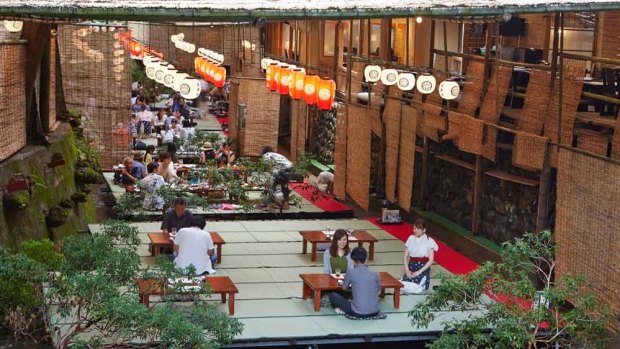By Claire Isaac

Kawadoko is a Kyoto style of restaurant where the floor is placed over and/or beside a river to welcome customers in summer.
SPONSORED CONTENT
Japan may be foodie famous for its sushi and sashimi, but it's the lesser known fare (that's not at all raw) that will really get you salivating.
Sukiyaki
Sukiyaki, traditionally served in winter, is the ultimate warming dish. A hot pot style stew that's cooked and served at the table, it consists of meat (usually thinly sliced beef) which is slowly cooked or simmered with vegetables in a shallow iron pot in a mixture of soy sauce, sugar and mirin. The literal meaning of sukiyaki is "grilling (yaki) on a spade or shovel (suki)" and it appears in cookbooks from as far back as the Edo period of Japanese history (1603-1868).
Shabu-shabu
Another cooked-at-the-table dish, shabu-shabu is served fondue style with meat slices and veggies cooked quickly in boiling broth then dipped in ponzu sauce – a dark, tangy sauce with a citrus base. The dish originally surfaced in Osaka, where the name was invented – though its origins are traced back to the Chinese hot pot. These days shabu-shabu is a common dish in all tourist hot-spots, eagerly awaiting your discovery.
Takoyaki
Octopus balls may not sound appealing, but believe us when we say these crispy dumplings are full of flavour. Piping hot balls of batter filled with diced octopus, tempura bubbles, pickled ginger and green onion, they're then covered in Japanese mayo, special BBQ-style sauce and bonito flakes. A common dish among street food stalls and many well-established takoyaki specialty restaurants, particularly in the Kansai region.
Okonomiyaki
A Japanese savoury pancake, the name okonomiyaki is derived from the word okonomi, meaning "how you like" or "what you like", and yaki meaning "grill". Mainly associated with the Kansai and Hiroshima regions, it's widely available throughout Japan. Toppings and batters vary according to region but expect shredded cabbage and other ingredients such as green onion, meat (generally thin pork belly), octopus, squid, shrimp and vegetables. Okonomiyaki is sometimes compared to an omelette or a pancake and even referred to as a "Japanese pizza".
Japanese curry
Curry was introduced to Japan by the British, at a time when India was under the colonial rule of the British Raj. These days curry is everywhere (in fact you could call it a national dish), and even at breakfast time you'll witness businessmen slurping up their bowls. It's served in three main forms: curry rice, curry udon and curry bread (a yummy curry-filled deep-fried pastry). Though Japanese curry originated from Indian curries, the taste has evolved to be quite different: Japanese curries tend to be thicker and a little sweeter.
Yakisoba
Literally meaning "fried buckwheat," yakisoba is a noodle stir-fry dish. It first appeared in food stalls during the early 20th century and to this day, it's one of the most popular street foods in Japan. It's generally prepared by frying wheat noodles with pork and veg (usually cabbage, onions and carrots) and flavoured with yakisoba sauce, salt and pepper, then served with a variety of garnishes, such as powdered seaweed, pickled ginger, bonito flakes and mayonnaise. For a quick snack, it can also be served in a bun, like a hot dog – called yakisoba-pan.
Yakitori
Yakitori is a popular street food – and a delicious one at that. Its small servings of skewered grilled chicken (although they do branch out into pork, beef, quail eggs and other bite-sized morsels) are huge on flavour. Yakitori is often sold from small carts and stalls known as yatai, where customers can enjoy beer and sake with their snack on the way home from work. Today yakitori can be found all over Japan, but it's said to have originated in Nagano in the Edo era.
Ramen
No trip to Japan is complete without a ramen stop (or two!). Said to have arrived on Japan's shores via China, the first specialised ramen shop opened in Asakusa in 1910. This feel-good food is a mix of wheat noodles served in a broth, often flavoured with soy sauce, miso, or pork-bone then topped with additions like sliced pork, seaweed, green onions and eggs. Nearly every region in Japan has its own variation, and slurping up a big bowl of ramen while the world goes by is a true pleasure. Enjoy!
Kakigori
This shaved ice treat is a staple all over Japan in the summer. Don't mistake it for a regular snow cone, this fluffy and light concoction is eaten with a spoon – perfect for savouring the sweet taste. Some shops serve it with ice cream and red beans or shiratama (dumplings made of 'mochi' rice flour) and sweetened with condensed milk.
Kawadoko (Noryo-yuka)
More a style of dining than an actual cuisine, Kawadoko is (almost literally) river bed or riverside dining, specific to Kyoto and the surrounding areas such as Kibune in the height of summer. Kawadoko are said to have started with teahouses putting out folding stools into the river to allow customers to cool their feet - a great example of how people in days gone by overcame the hot and humid summers of Kyoto. Every year, you will find restaurants and teahouses in Kyoto opening up balconies along the river to serve food. Sometimes wooden platforms will be raised directly above the riverbed. The river location means fish often play a big part in the menus.
See also: Undiscovered Japan by Road
See also: Hiking in Japan? Yes, you can
This article is brought to you by Japan National Tourism Organization.
Looking for a warm getaway during the Australian winter? Find the best travel ideas for summer in Japan, along with inspiration and travel tips at Japan National Tourism Organization's website, jnto.org.au
Sign up for the Traveller Deals newsletter
Get exclusive travel deals delivered straight to your inbox. Sign up now.